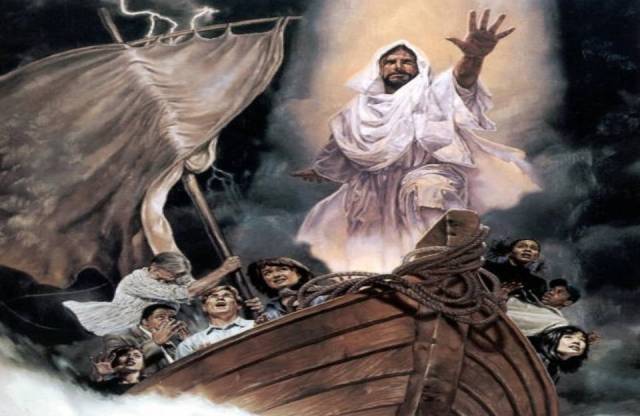The first Christmas Day was the moment when eternity announced its presence in time. The immense and the everlasting pierced the thin veil of time.
The power of eternity was made manifest in the weakness of a newborn infant, the most powerless of any human being. And on that paradox, human history has pivoted.
The circumstances were surely as inauspicious as any could be. Mary and Joseph were a refugee family fleeing the savage persecution of Herod and finding rough, temporary shelter.
Remember Mother Teresa, when she picked up a tiny newborn in Kolkata, in circumstances so daunting that birth at all was a miracle: “See! There’s life in her!”
And yet there was also splendour at the first Christmas, as the three magi, the wise men, came to offer gifts.
Christmas remains the most universal, powerful symbol of both humanity and divinity, not only in the West but in the entire world. I have listened, transfixed with delight, to Christmas carols sung in hotel lobbies in Muslim Kuala Lumpur and in many other places.
Christmas has always had its enemies. The chief project of modernity over the past 200 years has been to try to kill God. Even where this dismal endeavour progresses culturally, the God that cannot be killed at all is the infant at Christmas.
Still, as Dickens suggested in A Christmas Carol, you can tell something about a person, and a culture, by their attitude to Christmas.
Thus, in a kind of Monty Python version of antique political correctness beyond parody, the Diversity Council advises companies not to hold Christmas celebrations. I have the closest family and friendship connections with people of many faiths and I have never heard one object to, or fail to enjoy, Christmas celebrations.
Still, it would be wrong to make too much of the Diversity Council’s well-intentioned silliness.
The objection to Christmas comes not from other religions — most celebrate each others’ festivals happily — but from the grinches of militant secularism, the official and dispiriting religion of our time.
In truth, Christmas is a universal symbol that spreads nothing but goodwill and hope to everyone. At every Christmas table surely every neighbour is welcome. It is also true that Christianity is true. And that it is completely distinctive.
It is a common argument against Christianity that the essential wonder of Christmas — of the everlasting, eternal, all-powerful God becoming a defenceless human baby in deepest obscurity — is similar to other religious traditions that also have some men as gods and some gods as men.
It is a characteristic mistake of atheism to hold that the similarities of different religious traditions show that they are all just artificial artefacts, manufactured by men and women like a table or a car. The reverse is true. The recurrence of motifs throughout humanity is rather a sign that a sense of God, an intuition even of the shape of God, of the commerce between heaven and earth, is hardwired into the deepest elements of human nature.
In any event, no other religious tradition has anything equivalent to Christmas. Ancient Roman emperors were sometimes elevated to the status of gods, but theologically this is not much more than saying that Don Bradman was the god of cricket.
Other religions that have gods become men date them to a mythical time. Thus Hinduism, with its deep spiritual beauty and elevated literature, describes Krishna’s adventures on Earth in a time before time.
Christianity stakes its claims to truth on specific historical events in a well-documented time.
No other religion has its supreme god seemingly defeated on Earth, arrested, tortured, humiliated and killed in the most gruesome fashion.
One of our best-credentialled and most prolific historians of biblical times, John Dickson, who teaches at Oxford and Sydney universities, has written a marvellous new book, Is Jesus History?
You could make no greater contribution to cultural literacy than encouraging everybody, certainly every high school and university student, to read it.
Sydney’s Catholic Archbishop, Anthony Fisher, in an enthralling consideration of our historical circumstance, argued recently that Australia is both partly post-Christian and partly pre-Christian.
The two social conditions are somewhat different, but one thing they have in common is a ignorance about the basic facts of Christianity.
Dickson is a believing Christian but in Is Jesus History? he writes as a historian and expertly, readably, shrewdly, unemotionally draws together the most important scholarship on the historical Jesus.
The former Pope Benedict, in his magisterial, scholarly book, Jesus of Nazareth, explains the importance of historicity: “It is of the very essence of biblical faith to be about real historical events. It does not tell stories symbolising supra-historical truths, but is based on history, history that took place here on this Earth.”
Benedict also explains the severe limits of the historical-critical method in trying to deconstruct the New Testament. Concerning biblical critical studies, which once in their wilder speculations did much to undermine religious faith, Benedict writes: “We have to keep in mind the limits of all our efforts to know the past: We can never go beyond the domain of hypothesis because we simply cannot bring the past into the present. To be sure, some hypotheses enjoy a high degree of certainty, but overall we need to remain conscious of the limit of our certainties.”
Dickson makes a different but allied point. Historical research and understanding can only take you to the threshold of decision about whether you believe that the physical resurrection of Jesus, and all the other miracles, took place. History cannot prove the miracles; history certainly cannot disprove them either.
It is similar to the arguments about the existence of God. Reason alone can take you to belief in God, as it did with some ancient Greek philosophers. But reason alone does not prove God. Nor does reason disprove God. There is nothing unreasonable, or irrational, about believing in God.
Our culture reinforces the wholly fraudulent message that science has somehow taken a stand against God. This is untrue and not the least of popular culture’s misrepresentations of science. As our greatest poet, Les Murray, wrote: “Snobs mind us off religion nowadays, if they can.”
Dickson thinks that history can tell us a great deal about Jesus. The overwhelming weight of all recent real research evidence validates the key narrative points of the gospel and other New Testament stories about Jesus.
Dickson assesses the evidence coolly and fairly.
There are several non-Christian references to Jesus in the ancient world. The earliest New Testament texts are some of the letters of Paul, written perhaps 20 years after Jesus’ death. These letters are written to communities of Jesus’ followers who already believe that Jesus rose from the dead and is the son of God. These beliefs are almost universal among Jesus’ followers.
Dickson establishes that the books of the New Testament are the best authenticated documents of the ancient world, apart from inscriptions in stone.
Most of the New Testament scriptures were written independently of each other and their minor discrepancies tend to validate their authenticity.
He offers the illustration. You probably recall exactly when you met your spouse for the first time. But as you tell the story over and over, sometimes you say you were drinking a beer, at other times a glass of wine.
But the name of your spouse, and the impression they made on you, is vivid and unvarying.
Similarly, every archaeological discovery has tended to confirm the authenticity of the Jewish community that the gospels describe. Similarly, the empty tomb of Jesus after his death is recounted in the gospel of Mark, the gospel of John and Paul’s letter to the Corinthians. These were all written independently of each other.
Then, outside the New Testament, there is strong evidence that leaders of Jerusalem in the decades following Jesus’ death claimed that disciples had stolen the body to create an empty tomb. The point of this evidence is that these authorities believed there was an empty tomb that they had to explain.
Perhaps most piquant, the discoverers of the empty tomb were women. But in the ancient Middle East women were regarded as unreliable witnesses, their testimony much discounted in courts. Therefore, as Dickson writes: “If you were making up a story about the resurrection and you wanted your fellow first century readers to believe it, you would not include women as the initial witnesses, unless it happened, perhaps embarrassingly, to be true.”
Dickson is a historian of the highest calibre and he concludes: “If the central claim of Christianity were not a miraculous resurrection but just some extraordinary natural claim, everyone would believe it — assuming we had the same degree of historical evidence which we possess for the resurrection.”
It is important not to misrepresent Dickson here. He is emphatically not claiming history proves the resurrection or the divinity of Jesus.
What history does establish, almost beyond reasonable doubt, is that Jesus lived at the time the gospels say, that he said at least many of the things attributed to him, that he had a reputation as a miracle worker and that his earliest followers, soon after his death, claimed to have seen him, and that the broad movement of his followers believed he had risen from the dead and was the son of God. Many of them believed this so passionately that they went to their deaths rather than deny their beliefs.
These historical facts do not prove that Christianity is true or that Jesus is the son of God.
But the bigoted atheism of our time, which dismisses the rational belief of 2000 years, and holds that all of this is not only not true but mere myth and superstition invented decades or centuries later, is deeply ignorant. It is a completely unearned vanity of the moment, which self-regardingly treats contemporary derangements as timeless and obvious wisdom. This is why it would be so valuable for people to read Dickson’s book, to get some real sense of the evidence.
Even more valuable would be to read a couple of the books of the New Testament itself.
Kanishka Raffel is the dean of St Andrew’s Anglican Cathedral in Sydney. Born in London to Sri Lankan parents, he came to Australia as a child. As a 21-year-old undergraduate at the University of Sydney, he was asked by a friend to read something about Christianity. He thought he would get a book by CS Lewis or some such. Instead his friend got him to read St John’s gospel. I asked him about that experience: “I was struck by the vitality of Jesus. You see him with his friends, arguing with sceptics, stunning the crowd. You also see him in prayer, in intimate contact with his father. In my particular case, having studied the Buddhist scriptures, you don’t really get a sense of the manhood of Buddha.
“Also, I was surprised by the historical realism of it, it’s rooted in time and place. The things Jesus says are very provocative. I found Jesus utterly compelling.”
Leaving aside religious considerations, here is a question of cultural literacy. Beyond the diminishing ranks of church-based religious instruction, is there a single course in any subject in any Australian school or university in which students would read the gospel of St John? Apart from the majesty of the writing — “In the beginning was the Word, and the Word was with God, and the Word was God” — isn’t it worth knowing something of the story at the heart of our civilisation?
Our enduring hope in all this remains that vulnerable and homeless infant of the first Christmas. For in weakness, his power is manifest.
Greg Sheridan’s book, God is Good for You, is published by Allen & Unwin.
https://www.theaustralian.com.au/inquirer/christmas-story-still-resonates-down-the-ages/news-story/d68fcbb1f72547028476282cb786c588





